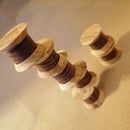Introduction: The Hand of the King Dip Pen
Dip pens have been around for ages. An there still going even when alternatives are available which are far easier to use. This is because there ace. They allow the user to have a lot more control of the line their producing and they look awesome.. Well some of them look awesome.. (If you make one that looks awesome it will look awesome)
Also if like me you have started to collect creative tools and equipment the dip pen and ink combo will always make you look like a steam punk genius wizard. Its a good look.
So knowing that everyone needs a dip pen in their life and having at least one person in my life who would love to have an extra special pen. I thought I would make an instructable for you lovely people whilst I made a few pens for some awesome people.
Step 1: Wood You?
I chose to use a scrap of black walnut which I squared off and cut to the length of just a little bit longer than a standard pencil.
The length is a fairly non standardized measurement but I thought that pencils and pens have been used for a long time so the length most pens and pencils are will be the right length for the greatest amount of people.. (I have made smaller and longer pens.. if your making your own you can experiment to find the best size for you)..
I rounded off the wood between centers which allows me to hold it more securely in my pin jaws.
Step 2: The Drilly Part
I centered the wood in the chuck using the drive center point as a guide.
I measured where I would need to drill to in order to insert the full length of the brass tube which came with my dip pen kits.
I then drilled to this measurement holding the drill bit in the my Jacobs chuck which I changed out from the live center.
Step 3: Gluing in the Tube
I abraded the brass tube to increase its surface area and to decrees the chances that contaminates would reduce the effectiveness of the super glue I used for this project.
I then glued in the drilled hole and the outside of the brass tube before inserting the tube into the hole using a pencil to hold the tube.
Step 4: Start to Shape
So hears the fun part.
I used a bowl gouge but that's mainly because I had it in my hand. I have just realized I did this whole project using only a bowl gouge.. So... Using your tool of choice, possibly a bowl gouge more likely a spindle gouge start to shape your pen.
I have settled on a wobble shape which is fairly universal when I have looked for references of dip pens. This shape is great and feels good when in use.
I would recommend stopping the lathe from time to time to test how it fits into your hand.
It is important to bare in mind how thick the brass tube is so you don't turn to deep and hit it.
You might want to carve finger and thumb notches to make the pen even more ergonomic at this point.
If I had planned a little better I would have applied finish to the end part of my pen at this point rather than at the end of the project as its more accessible now than at the end and you can use the lathe to assist sanding and application.
Step 5: More Shaping and Sanding
I took the pen out of the chuck and installed a center to hold the pen between it and the live center.
I made a few alterations to the pens shape before starting to shape the tail end.
I nibbled in towards the drive center instead of working the whole peace to its desired diameter as I didn't want to introduce weakens. This method allows the wood which hadn't been turned to a thin diameter to maintain rigidity whilst turning.
Once I was happy with the shape I sanded to 1200 grit.
When sanding the fastest way to get great results is working through the grits.. starting with a low number and progressing through the numbers until you get to at least 600. each step should remove the scratch marks of the step before it, and shouldn't take more than a few passes.
Step 6: CA Is an Excellent Finish
I love using super glue as a finish, I use the really cheep £1 shop stuff which is very thin and acts as its own sanding sealer.
I applied a few coats before sanding it down and using burnishing cream to bring out a high glass like gloss.
Step 7: Part It Off
You could use a parting tool. I used a very aggressive spindle gouge to part the pen and shape the end point.
I left a small amount to pare away at the end in order to avoid tier out and used a chisel to remove this part.
Step 8: Sand and Finish the Remaining Bits
sand and finish the remaining bits
Step 9: Install the Nib Holder and the Nib
My kit came with nib holder inserts, brass tubes and a few nibs.
I inserted the nib holder insert by pushing it into place and then inserted the nib which resulted in a finished pen.
It is a good idea to avoid inserting the nib by applying any pressure to the end part. this is the delicate bit which if its bent out of place the pen will not work properly, until you replace the nib , nibs are relatively cheep and come in a whole world of interesting styles which are well worth playing with.
Step 10: I Hope You Have Enjoyed This Instructable
If you have enjoyed this instructable feel free to let me know and if you make a dip pen I would love to see it.
Also You might have missed it but the first image is actually a video showing how I made the dip pen. :)
I have been asked where the kits are available.. I am in no way affiliated with the companies I am about to link to. The results are the result of a google search:
http://www.thegoldennib.com/pen-kits/dip-pens/nib-...
http://www.nativepens.co.nz/calligraphy-dip-pen-ki...
There are lots of places where the inserts can be found and prices will be different from different suppliers. Hopefully the links will help you find the fight supplier for you.

Runner Up in the
Leftovers Challenge

Participated in the
Homemade Gifts Contest 2015













